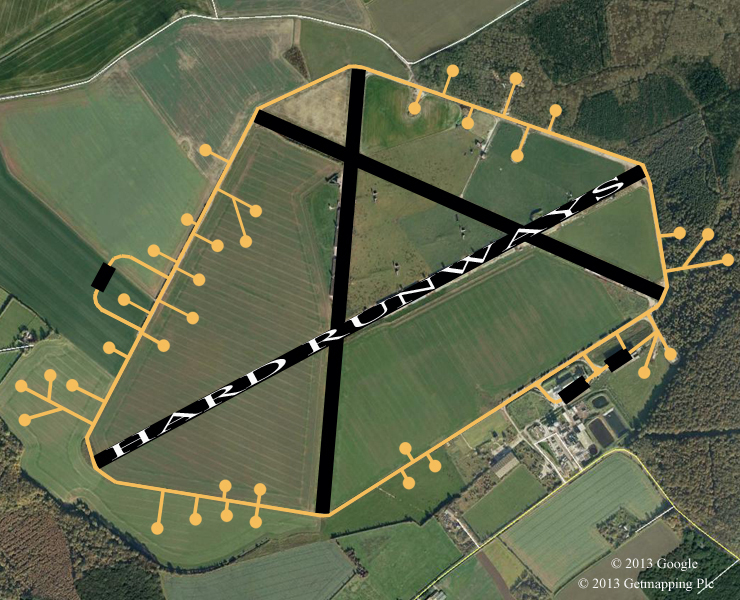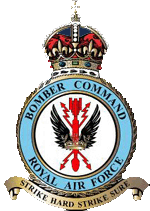Bardney Airfield History

(Map edited to show the airfield and runways between 1940-45)

© Crown Copyright/MOD 2010
53°13'35.01"N 0°17'35.37"WRunways:
01/19 & 12/30 4200ft x 150ft & 07/25 6000ft x 150ft
The entrance to the former RAF Bardney airfield can be found 1.5 miles north-east of Bardney village on Henry Lane. Opened on 18th January 1943 and built as a Class 'A' bomber airfield for 5 Group, it had the usual three intersecting concrete runways arranged in a triangular layout connected by a 50ft wide perimeter track which gave access to 36 aircraft dispersals. At Class 'A' standard airfields, the main runway was 2000 yards long and the two subsidiary runways were each 1400 yards in length all at a width of 50 yards. The technical site at Bardney was located between the main entrance and the perimeter track and contained workshops, stores, briefing rooms and a watch office amongst others. Two hangars, a T2 and a B1, were also located in the technical site, with a further T2 located off the western perimeter track. Communal and accommodation sites were dispersed in woodland to the south; the bomb stores were located in Austacre Wood north-east of the airfield.
Bardney airfield was home to No.9 Squadron's Lancasters for most of its wartime life, the unit arriving from Waddington on 14th April 1943 and staying until the end of the war. On 7th October 1944, No.9 Squadron's 'A' Flight was used to reform No.227 Squadron, which stayed at Bardney until 12th October 1944, when it relocated to Balderton, Nottinghamshire. In November 1944, No.9 Squadron joined No.617 Squadron at RAF Lossiemouth, Scotland. From here, on 12th November 1944, armed with 12,000Ib Tallboy bombs, they took part in Operation Catechism - the successful attack on the German battleship Tirpitz in Tromso Fjord, Norway. The Tirpitz was struck by two bombs and capsized.
Towards the end of the war in Europe, No.189 Squadron arrived from Fulbeck on 8th April 1945, staying until October when it moved to Metheringham. Both No.227 Squadron and No.189 Squadron were equipped with Lancasters. The Bomber Command Film Unit was formed and based at Bardney in the latter stages of the war.
At the end of the war Bardney, although disused, was retained by the RAF into the 1960's as a base for Thor Medium Range Ballistic Missiles.
The airfield is still visible today, particularly from the air, where rows of modern chicken sheds mark the runways. Some technical site buildings are still extant, including the hangars and the watch office (which is used as a clubhouse for a model aircraft flying club). In Bardney village itself, a fine memorial to No.9 Squadron can be seen.
| Date | Squadron | Notes |
|---|---|---|
| January 1943 | Station opened. | |
| April 1943 | No.9 Sqn | Operating the Avro Lancaster. The squadron left the station on the 6th July 1945. |
| October 1944 | No.189 Sqn | Operating the Avro Lancaster. The squadron left the airfield on the 2nd November 1944. |
| October 1944 | No.227 Sqn ('A' Flt) | Operating the Avro Lancaster. The flight left Bardney on the 21st October 1944. |
| April 1945 | No.189 Sqn | Operating the Avro Lancaster. The squadron left the airfield on the 15th October 1945. |
| October 1945 | RAF Bardney placed on Care and Maintenance. The Station was used during this time by the British Army for vehicle storage until 1958. | |
| July 1959 | No.106 Sqn | Operating the Thor Missile Unit. The Squadron disbanded at the station on the 24th May 1963. |
| 1963 | RAF Bardney closed. |
